Cyber Violence in the UK: Causes, Impacts, and Regulatory Framework
VerifiedAdded on 2021/05/30
|10
|2816
|299
Report
AI Summary
This report delves into the multifaceted issue of cyber violence, exploring its definition, causes, and impact on individuals and society, with a specific focus on the UK context. The study highlights the rapid increase in cyber violence, particularly among teenagers, and identifies social media as a key facilitator. It examines various factors contributing to cyber violence, including easy internet access, data storage capabilities, negligence, and the rapid expansion of social media applications. The report also explores the psychological and social impacts of cyber violence, such as anxiety, depression, and social exclusion. Furthermore, it discusses the regulatory processes and legal frameworks in place to combat cyber violence in the UK, including the Computer Misuse Act 1990, the Data Protection Act, and the Harassment Act 1997. The research methodology employs a positivism philosophy and a deductive approach, utilizing a descriptive research design and primary data collection through surveys. The ethical considerations, including data protection and appropriate citation, are also addressed. The report concludes by emphasizing the need for increased awareness, individual protective measures, and governmental regulations to effectively mitigate cyber violence.
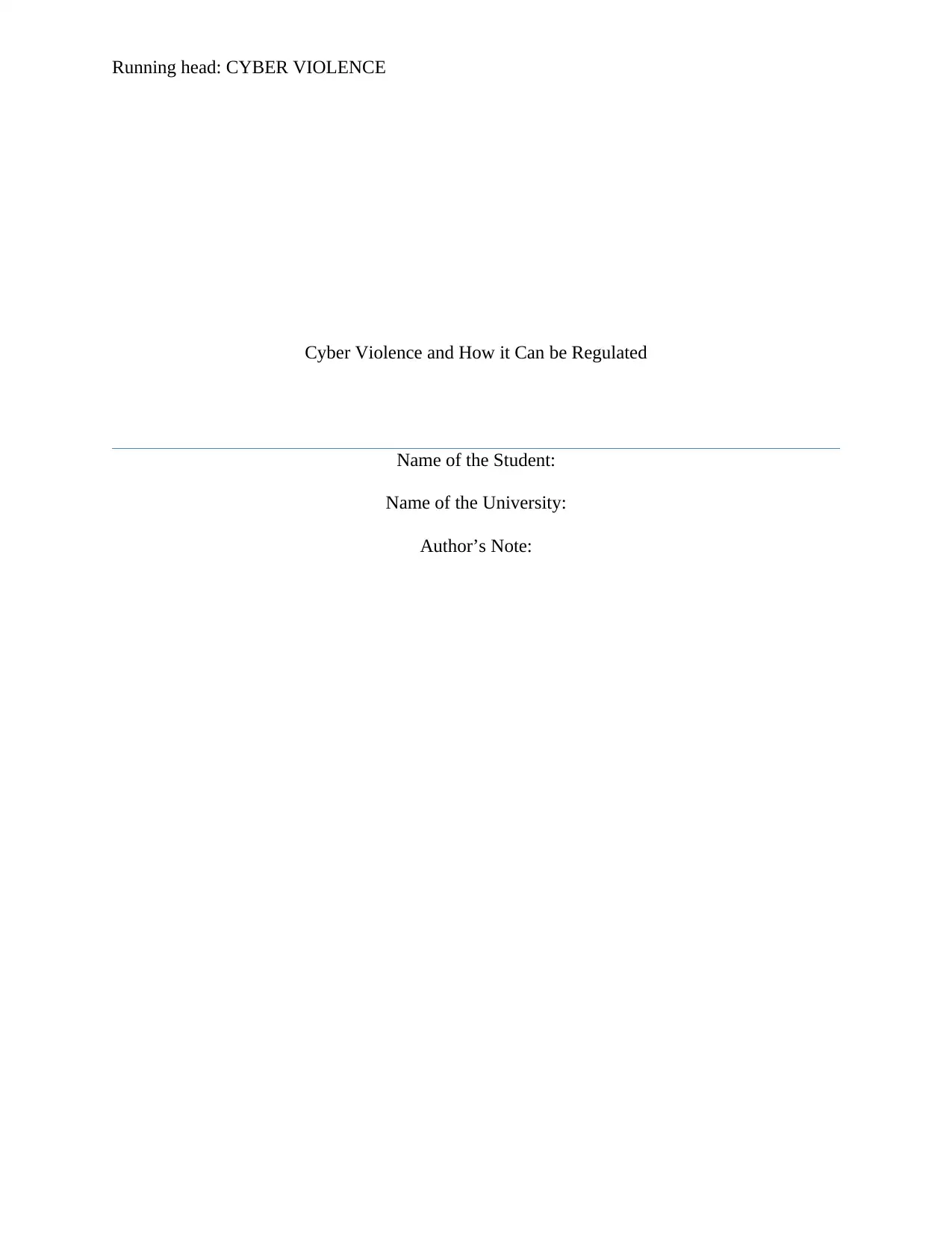
Running head: CYBER VIOLENCE
Cyber Violence and How it Can be Regulated
Name of the Student:
Name of the University:
Author’s Note:
Cyber Violence and How it Can be Regulated
Name of the Student:
Name of the University:
Author’s Note:
Paraphrase This Document
Need a fresh take? Get an instant paraphrase of this document with our AI Paraphraser
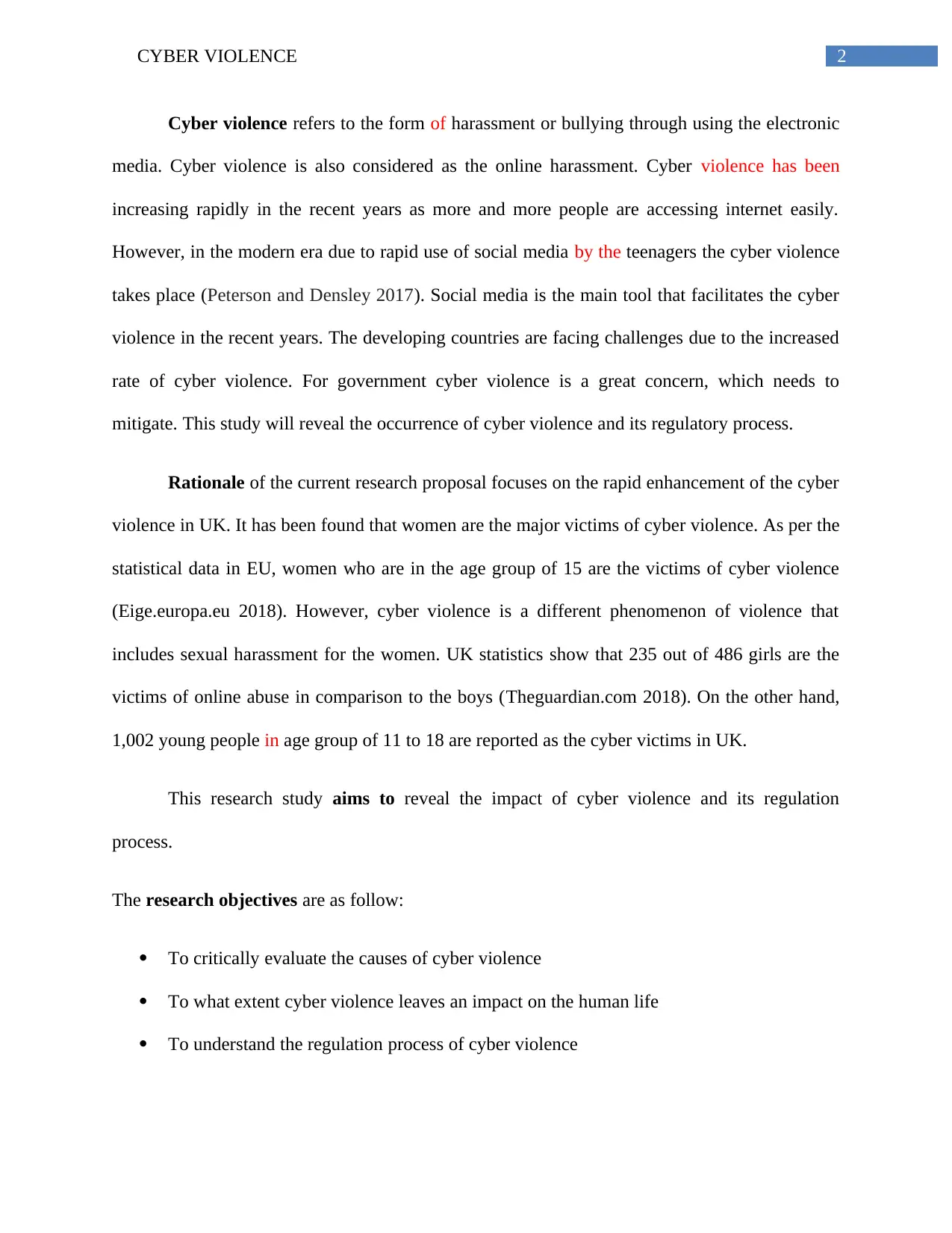
2CYBER VIOLENCE
Cyber violence refers to the form of harassment or bullying through using the electronic
media. Cyber violence is also considered as the online harassment. Cyber violence has been
increasing rapidly in the recent years as more and more people are accessing internet easily.
However, in the modern era due to rapid use of social media by the teenagers the cyber violence
takes place (Peterson and Densley 2017). Social media is the main tool that facilitates the cyber
violence in the recent years. The developing countries are facing challenges due to the increased
rate of cyber violence. For government cyber violence is a great concern, which needs to
mitigate. This study will reveal the occurrence of cyber violence and its regulatory process.
Rationale of the current research proposal focuses on the rapid enhancement of the cyber
violence in UK. It has been found that women are the major victims of cyber violence. As per the
statistical data in EU, women who are in the age group of 15 are the victims of cyber violence
(Eige.europa.eu 2018). However, cyber violence is a different phenomenon of violence that
includes sexual harassment for the women. UK statistics show that 235 out of 486 girls are the
victims of online abuse in comparison to the boys (Theguardian.com 2018). On the other hand,
1,002 young people in age group of 11 to 18 are reported as the cyber victims in UK.
This research study aims to reveal the impact of cyber violence and its regulation
process.
The research objectives are as follow:
To critically evaluate the causes of cyber violence
To what extent cyber violence leaves an impact on the human life
To understand the regulation process of cyber violence
Cyber violence refers to the form of harassment or bullying through using the electronic
media. Cyber violence is also considered as the online harassment. Cyber violence has been
increasing rapidly in the recent years as more and more people are accessing internet easily.
However, in the modern era due to rapid use of social media by the teenagers the cyber violence
takes place (Peterson and Densley 2017). Social media is the main tool that facilitates the cyber
violence in the recent years. The developing countries are facing challenges due to the increased
rate of cyber violence. For government cyber violence is a great concern, which needs to
mitigate. This study will reveal the occurrence of cyber violence and its regulatory process.
Rationale of the current research proposal focuses on the rapid enhancement of the cyber
violence in UK. It has been found that women are the major victims of cyber violence. As per the
statistical data in EU, women who are in the age group of 15 are the victims of cyber violence
(Eige.europa.eu 2018). However, cyber violence is a different phenomenon of violence that
includes sexual harassment for the women. UK statistics show that 235 out of 486 girls are the
victims of online abuse in comparison to the boys (Theguardian.com 2018). On the other hand,
1,002 young people in age group of 11 to 18 are reported as the cyber victims in UK.
This research study aims to reveal the impact of cyber violence and its regulation
process.
The research objectives are as follow:
To critically evaluate the causes of cyber violence
To what extent cyber violence leaves an impact on the human life
To understand the regulation process of cyber violence
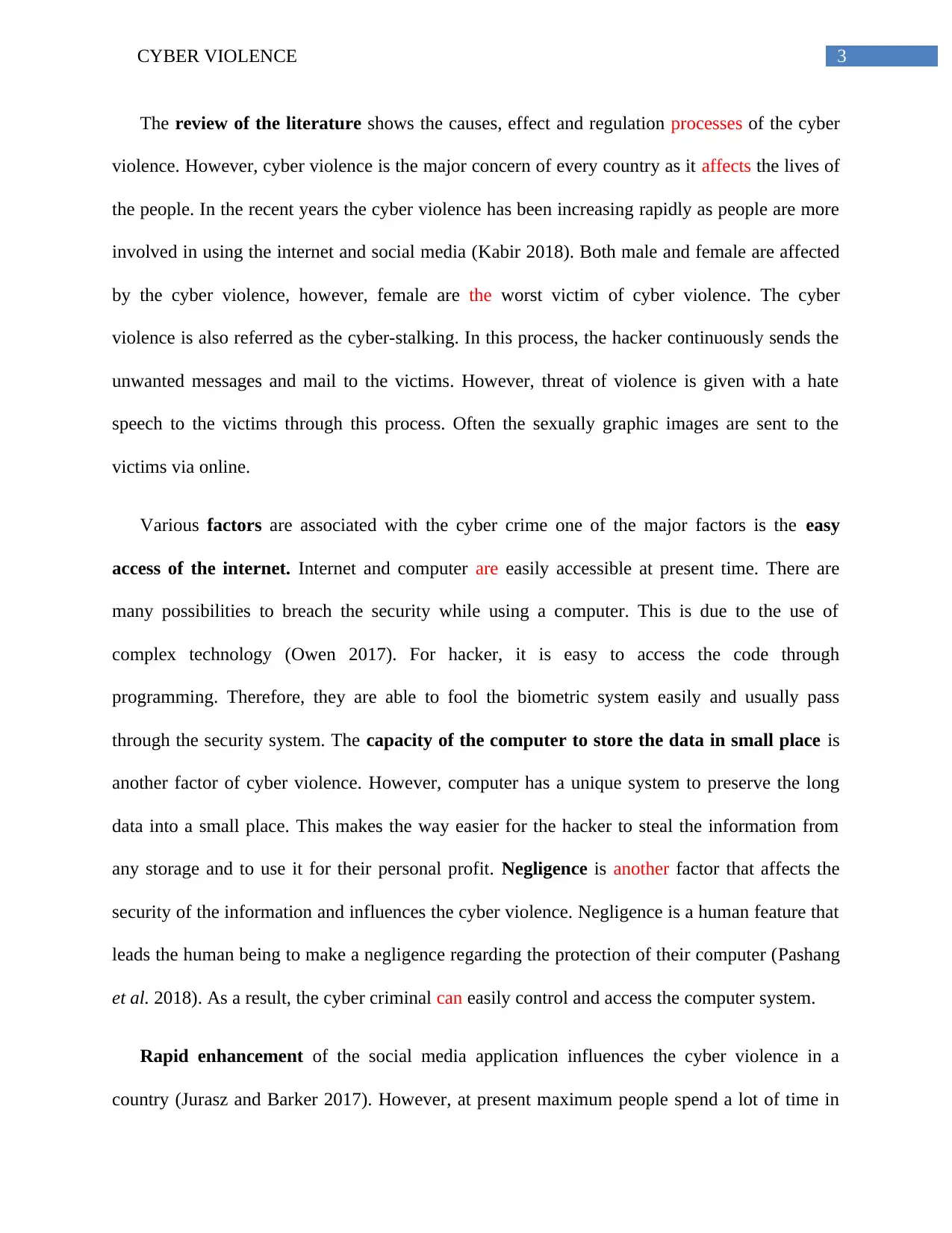
3CYBER VIOLENCE
The review of the literature shows the causes, effect and regulation processes of the cyber
violence. However, cyber violence is the major concern of every country as it affects the lives of
the people. In the recent years the cyber violence has been increasing rapidly as people are more
involved in using the internet and social media (Kabir 2018). Both male and female are affected
by the cyber violence, however, female are the worst victim of cyber violence. The cyber
violence is also referred as the cyber-stalking. In this process, the hacker continuously sends the
unwanted messages and mail to the victims. However, threat of violence is given with a hate
speech to the victims through this process. Often the sexually graphic images are sent to the
victims via online.
Various factors are associated with the cyber crime one of the major factors is the easy
access of the internet. Internet and computer are easily accessible at present time. There are
many possibilities to breach the security while using a computer. This is due to the use of
complex technology (Owen 2017). For hacker, it is easy to access the code through
programming. Therefore, they are able to fool the biometric system easily and usually pass
through the security system. The capacity of the computer to store the data in small place is
another factor of cyber violence. However, computer has a unique system to preserve the long
data into a small place. This makes the way easier for the hacker to steal the information from
any storage and to use it for their personal profit. Negligence is another factor that affects the
security of the information and influences the cyber violence. Negligence is a human feature that
leads the human being to make a negligence regarding the protection of their computer (Pashang
et al. 2018). As a result, the cyber criminal can easily control and access the computer system.
Rapid enhancement of the social media application influences the cyber violence in a
country (Jurasz and Barker 2017). However, at present maximum people spend a lot of time in
The review of the literature shows the causes, effect and regulation processes of the cyber
violence. However, cyber violence is the major concern of every country as it affects the lives of
the people. In the recent years the cyber violence has been increasing rapidly as people are more
involved in using the internet and social media (Kabir 2018). Both male and female are affected
by the cyber violence, however, female are the worst victim of cyber violence. The cyber
violence is also referred as the cyber-stalking. In this process, the hacker continuously sends the
unwanted messages and mail to the victims. However, threat of violence is given with a hate
speech to the victims through this process. Often the sexually graphic images are sent to the
victims via online.
Various factors are associated with the cyber crime one of the major factors is the easy
access of the internet. Internet and computer are easily accessible at present time. There are
many possibilities to breach the security while using a computer. This is due to the use of
complex technology (Owen 2017). For hacker, it is easy to access the code through
programming. Therefore, they are able to fool the biometric system easily and usually pass
through the security system. The capacity of the computer to store the data in small place is
another factor of cyber violence. However, computer has a unique system to preserve the long
data into a small place. This makes the way easier for the hacker to steal the information from
any storage and to use it for their personal profit. Negligence is another factor that affects the
security of the information and influences the cyber violence. Negligence is a human feature that
leads the human being to make a negligence regarding the protection of their computer (Pashang
et al. 2018). As a result, the cyber criminal can easily control and access the computer system.
Rapid enhancement of the social media application influences the cyber violence in a
country (Jurasz and Barker 2017). However, at present maximum people spend a lot of time in
⊘ This is a preview!⊘
Do you want full access?
Subscribe today to unlock all pages.

Trusted by 1+ million students worldwide
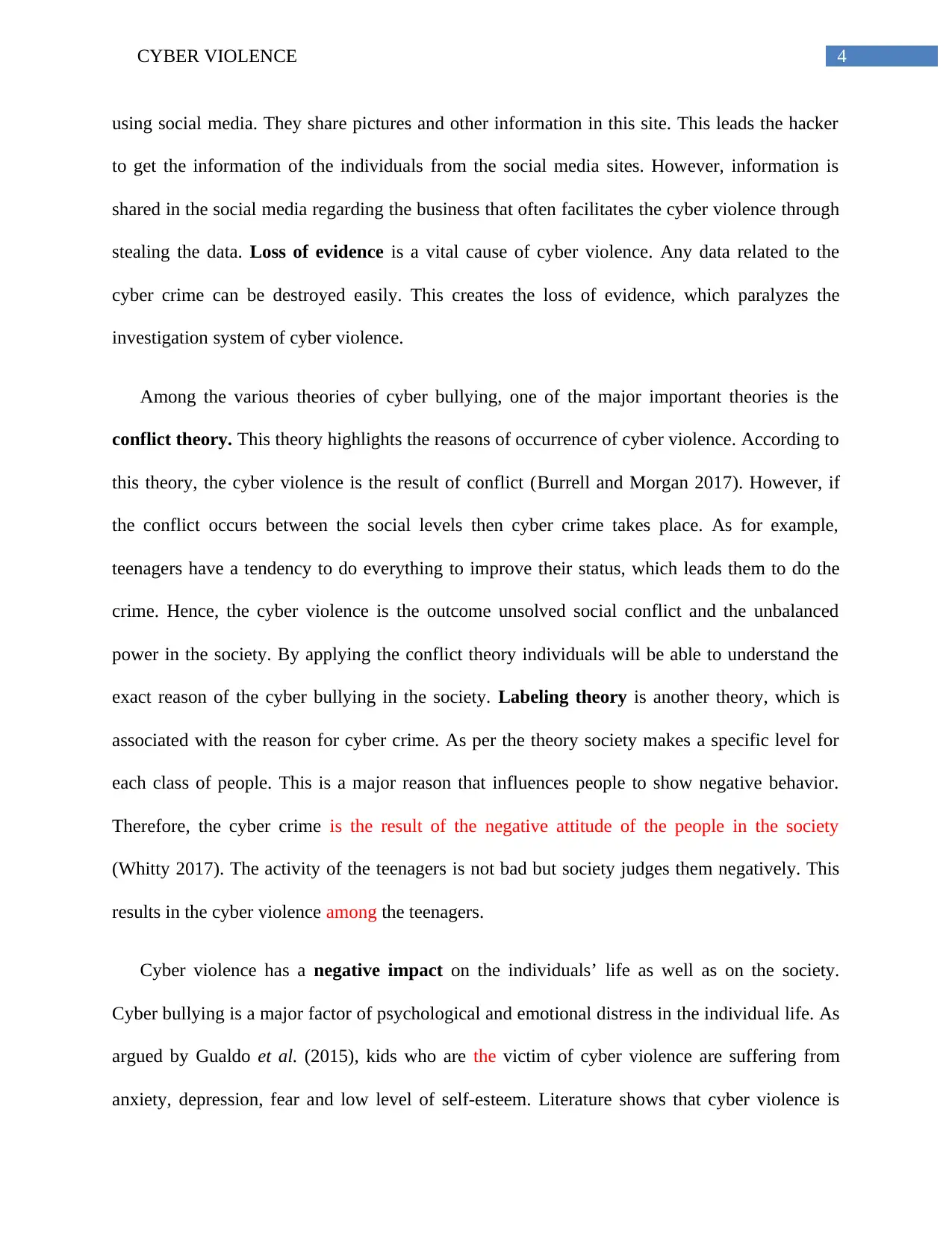
4CYBER VIOLENCE
using social media. They share pictures and other information in this site. This leads the hacker
to get the information of the individuals from the social media sites. However, information is
shared in the social media regarding the business that often facilitates the cyber violence through
stealing the data. Loss of evidence is a vital cause of cyber violence. Any data related to the
cyber crime can be destroyed easily. This creates the loss of evidence, which paralyzes the
investigation system of cyber violence.
Among the various theories of cyber bullying, one of the major important theories is the
conflict theory. This theory highlights the reasons of occurrence of cyber violence. According to
this theory, the cyber violence is the result of conflict (Burrell and Morgan 2017). However, if
the conflict occurs between the social levels then cyber crime takes place. As for example,
teenagers have a tendency to do everything to improve their status, which leads them to do the
crime. Hence, the cyber violence is the outcome unsolved social conflict and the unbalanced
power in the society. By applying the conflict theory individuals will be able to understand the
exact reason of the cyber bullying in the society. Labeling theory is another theory, which is
associated with the reason for cyber crime. As per the theory society makes a specific level for
each class of people. This is a major reason that influences people to show negative behavior.
Therefore, the cyber crime is the result of the negative attitude of the people in the society
(Whitty 2017). The activity of the teenagers is not bad but society judges them negatively. This
results in the cyber violence among the teenagers.
Cyber violence has a negative impact on the individuals’ life as well as on the society.
Cyber bullying is a major factor of psychological and emotional distress in the individual life. As
argued by Gualdo et al. (2015), kids who are the victim of cyber violence are suffering from
anxiety, depression, fear and low level of self-esteem. Literature shows that cyber violence is
using social media. They share pictures and other information in this site. This leads the hacker
to get the information of the individuals from the social media sites. However, information is
shared in the social media regarding the business that often facilitates the cyber violence through
stealing the data. Loss of evidence is a vital cause of cyber violence. Any data related to the
cyber crime can be destroyed easily. This creates the loss of evidence, which paralyzes the
investigation system of cyber violence.
Among the various theories of cyber bullying, one of the major important theories is the
conflict theory. This theory highlights the reasons of occurrence of cyber violence. According to
this theory, the cyber violence is the result of conflict (Burrell and Morgan 2017). However, if
the conflict occurs between the social levels then cyber crime takes place. As for example,
teenagers have a tendency to do everything to improve their status, which leads them to do the
crime. Hence, the cyber violence is the outcome unsolved social conflict and the unbalanced
power in the society. By applying the conflict theory individuals will be able to understand the
exact reason of the cyber bullying in the society. Labeling theory is another theory, which is
associated with the reason for cyber crime. As per the theory society makes a specific level for
each class of people. This is a major reason that influences people to show negative behavior.
Therefore, the cyber crime is the result of the negative attitude of the people in the society
(Whitty 2017). The activity of the teenagers is not bad but society judges them negatively. This
results in the cyber violence among the teenagers.
Cyber violence has a negative impact on the individuals’ life as well as on the society.
Cyber bullying is a major factor of psychological and emotional distress in the individual life. As
argued by Gualdo et al. (2015), kids who are the victim of cyber violence are suffering from
anxiety, depression, fear and low level of self-esteem. Literature shows that cyber violence is
Paraphrase This Document
Need a fresh take? Get an instant paraphrase of this document with our AI Paraphraser
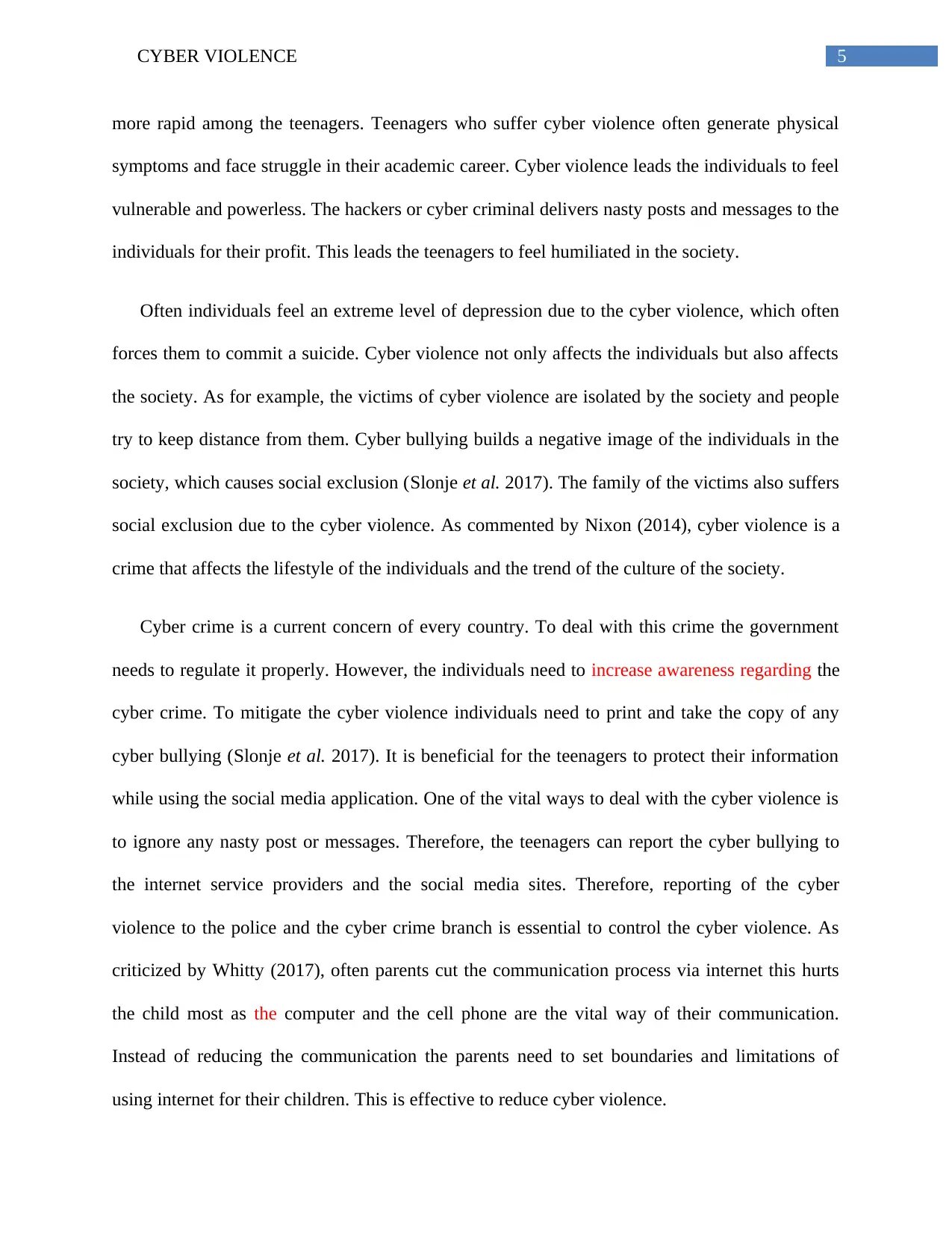
5CYBER VIOLENCE
more rapid among the teenagers. Teenagers who suffer cyber violence often generate physical
symptoms and face struggle in their academic career. Cyber violence leads the individuals to feel
vulnerable and powerless. The hackers or cyber criminal delivers nasty posts and messages to the
individuals for their profit. This leads the teenagers to feel humiliated in the society.
Often individuals feel an extreme level of depression due to the cyber violence, which often
forces them to commit a suicide. Cyber violence not only affects the individuals but also affects
the society. As for example, the victims of cyber violence are isolated by the society and people
try to keep distance from them. Cyber bullying builds a negative image of the individuals in the
society, which causes social exclusion (Slonje et al. 2017). The family of the victims also suffers
social exclusion due to the cyber violence. As commented by Nixon (2014), cyber violence is a
crime that affects the lifestyle of the individuals and the trend of the culture of the society.
Cyber crime is a current concern of every country. To deal with this crime the government
needs to regulate it properly. However, the individuals need to increase awareness regarding the
cyber crime. To mitigate the cyber violence individuals need to print and take the copy of any
cyber bullying (Slonje et al. 2017). It is beneficial for the teenagers to protect their information
while using the social media application. One of the vital ways to deal with the cyber violence is
to ignore any nasty post or messages. Therefore, the teenagers can report the cyber bullying to
the internet service providers and the social media sites. Therefore, reporting of the cyber
violence to the police and the cyber crime branch is essential to control the cyber violence. As
criticized by Whitty (2017), often parents cut the communication process via internet this hurts
the child most as the computer and the cell phone are the vital way of their communication.
Instead of reducing the communication the parents need to set boundaries and limitations of
using internet for their children. This is effective to reduce cyber violence.
more rapid among the teenagers. Teenagers who suffer cyber violence often generate physical
symptoms and face struggle in their academic career. Cyber violence leads the individuals to feel
vulnerable and powerless. The hackers or cyber criminal delivers nasty posts and messages to the
individuals for their profit. This leads the teenagers to feel humiliated in the society.
Often individuals feel an extreme level of depression due to the cyber violence, which often
forces them to commit a suicide. Cyber violence not only affects the individuals but also affects
the society. As for example, the victims of cyber violence are isolated by the society and people
try to keep distance from them. Cyber bullying builds a negative image of the individuals in the
society, which causes social exclusion (Slonje et al. 2017). The family of the victims also suffers
social exclusion due to the cyber violence. As commented by Nixon (2014), cyber violence is a
crime that affects the lifestyle of the individuals and the trend of the culture of the society.
Cyber crime is a current concern of every country. To deal with this crime the government
needs to regulate it properly. However, the individuals need to increase awareness regarding the
cyber crime. To mitigate the cyber violence individuals need to print and take the copy of any
cyber bullying (Slonje et al. 2017). It is beneficial for the teenagers to protect their information
while using the social media application. One of the vital ways to deal with the cyber violence is
to ignore any nasty post or messages. Therefore, the teenagers can report the cyber bullying to
the internet service providers and the social media sites. Therefore, reporting of the cyber
violence to the police and the cyber crime branch is essential to control the cyber violence. As
criticized by Whitty (2017), often parents cut the communication process via internet this hurts
the child most as the computer and the cell phone are the vital way of their communication.
Instead of reducing the communication the parents need to set boundaries and limitations of
using internet for their children. This is effective to reduce cyber violence.
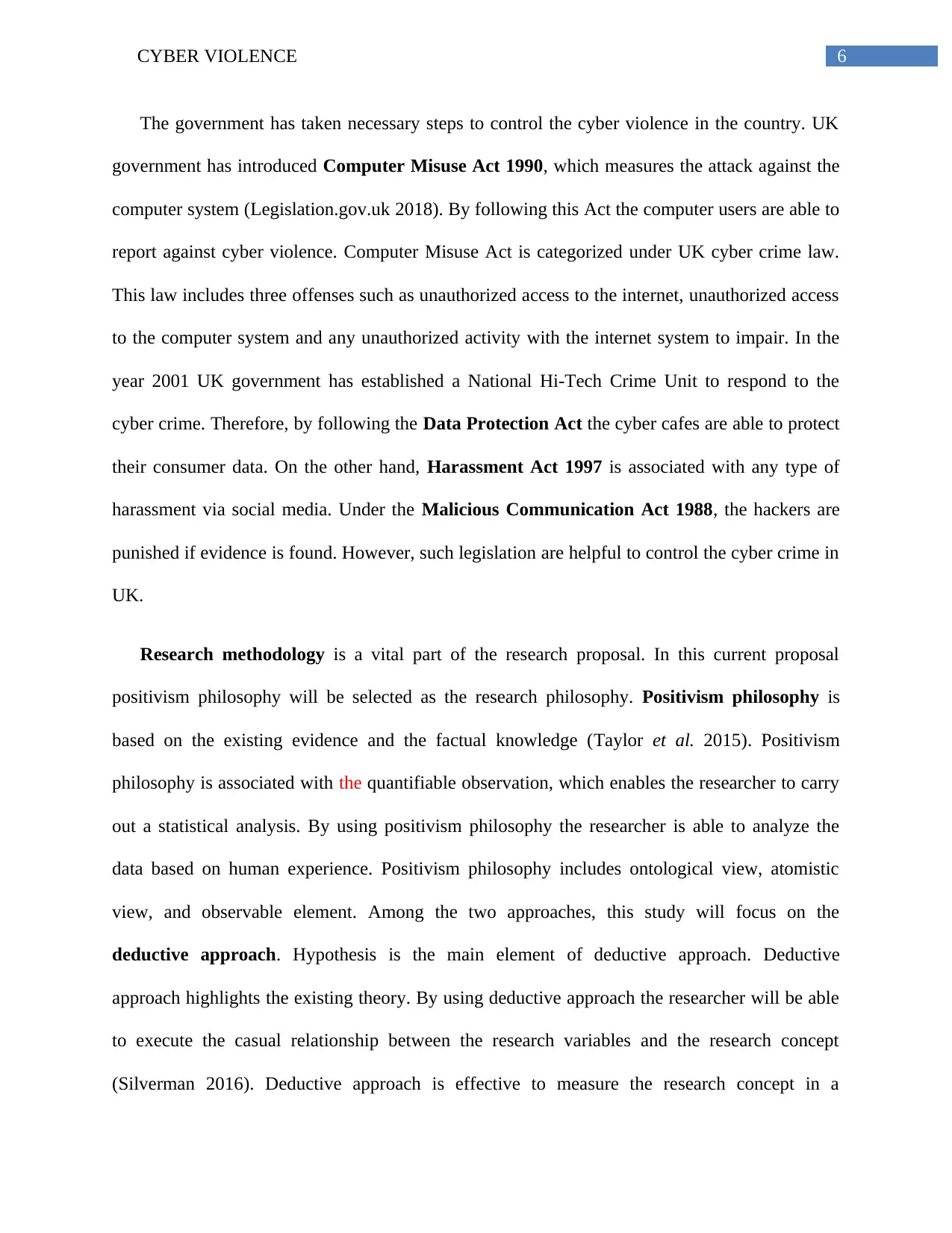
6CYBER VIOLENCE
The government has taken necessary steps to control the cyber violence in the country. UK
government has introduced Computer Misuse Act 1990, which measures the attack against the
computer system (Legislation.gov.uk 2018). By following this Act the computer users are able to
report against cyber violence. Computer Misuse Act is categorized under UK cyber crime law.
This law includes three offenses such as unauthorized access to the internet, unauthorized access
to the computer system and any unauthorized activity with the internet system to impair. In the
year 2001 UK government has established a National Hi-Tech Crime Unit to respond to the
cyber crime. Therefore, by following the Data Protection Act the cyber cafes are able to protect
their consumer data. On the other hand, Harassment Act 1997 is associated with any type of
harassment via social media. Under the Malicious Communication Act 1988, the hackers are
punished if evidence is found. However, such legislation are helpful to control the cyber crime in
UK.
Research methodology is a vital part of the research proposal. In this current proposal
positivism philosophy will be selected as the research philosophy. Positivism philosophy is
based on the existing evidence and the factual knowledge (Taylor et al. 2015). Positivism
philosophy is associated with the quantifiable observation, which enables the researcher to carry
out a statistical analysis. By using positivism philosophy the researcher is able to analyze the
data based on human experience. Positivism philosophy includes ontological view, atomistic
view, and observable element. Among the two approaches, this study will focus on the
deductive approach. Hypothesis is the main element of deductive approach. Deductive
approach highlights the existing theory. By using deductive approach the researcher will be able
to execute the casual relationship between the research variables and the research concept
(Silverman 2016). Deductive approach is effective to measure the research concept in a
The government has taken necessary steps to control the cyber violence in the country. UK
government has introduced Computer Misuse Act 1990, which measures the attack against the
computer system (Legislation.gov.uk 2018). By following this Act the computer users are able to
report against cyber violence. Computer Misuse Act is categorized under UK cyber crime law.
This law includes three offenses such as unauthorized access to the internet, unauthorized access
to the computer system and any unauthorized activity with the internet system to impair. In the
year 2001 UK government has established a National Hi-Tech Crime Unit to respond to the
cyber crime. Therefore, by following the Data Protection Act the cyber cafes are able to protect
their consumer data. On the other hand, Harassment Act 1997 is associated with any type of
harassment via social media. Under the Malicious Communication Act 1988, the hackers are
punished if evidence is found. However, such legislation are helpful to control the cyber crime in
UK.
Research methodology is a vital part of the research proposal. In this current proposal
positivism philosophy will be selected as the research philosophy. Positivism philosophy is
based on the existing evidence and the factual knowledge (Taylor et al. 2015). Positivism
philosophy is associated with the quantifiable observation, which enables the researcher to carry
out a statistical analysis. By using positivism philosophy the researcher is able to analyze the
data based on human experience. Positivism philosophy includes ontological view, atomistic
view, and observable element. Among the two approaches, this study will focus on the
deductive approach. Hypothesis is the main element of deductive approach. Deductive
approach highlights the existing theory. By using deductive approach the researcher will be able
to execute the casual relationship between the research variables and the research concept
(Silverman 2016). Deductive approach is effective to measure the research concept in a
⊘ This is a preview!⊘
Do you want full access?
Subscribe today to unlock all pages.

Trusted by 1+ million students worldwide

7CYBER VIOLENCE
quantitative way. This current research is based on the cyber violence and its regulation. Hence,
deductive approach helps the researcher to measure this concept properly. Descriptive,
explanatory and exploratory designs are the main three types of research design. In this current
study, descriptive design of the research will be undertaken. Descriptive design is applied to
analyze the current issue (Flick 2015). In this current study descriptive design will be helpful to
reveal the cyber violence issue in UK. Therefore, this research design will enable the researcher
to address the variables of the research.
In this current research, the primary data collection method will be used to gather the data.
The selected sample size will be 50 internet and social media users of a cyber café in UK. The
survey will be conducted among the internet users to gain feedback regarding their experience
with cyber violence. Questionnaires will be given via online to the participants. In this primary
research method, the quantitative data collection process will be chosen. Quantitative data
collection method is effective to obtain real-time data (Taylor et al. 2015). This study will focus
on the survey to gather real-time data from the candidates. However, in the literature review
section, the secondary research methodology will be conducted to gather information from the
existing journals, reports and online article.
Ethical consideration is a vital part of the research methodology. One of the major
ethical issues is the data protection. However, the researcher has to keep the confidentiality of
the personal information of the candidates. Therefore, during the survey, no personal question
can be asked to the candidates and the participants should not be forced to involve in the survey.
Therefore, data manipulation and inappropriate citation are the major ethical concerns. To deal
with such ethical issues a plan will be developed. Firstly the researcher has to follow the Data
Protection Act to maintain the security of the participant’s information. Therefore, data should
quantitative way. This current research is based on the cyber violence and its regulation. Hence,
deductive approach helps the researcher to measure this concept properly. Descriptive,
explanatory and exploratory designs are the main three types of research design. In this current
study, descriptive design of the research will be undertaken. Descriptive design is applied to
analyze the current issue (Flick 2015). In this current study descriptive design will be helpful to
reveal the cyber violence issue in UK. Therefore, this research design will enable the researcher
to address the variables of the research.
In this current research, the primary data collection method will be used to gather the data.
The selected sample size will be 50 internet and social media users of a cyber café in UK. The
survey will be conducted among the internet users to gain feedback regarding their experience
with cyber violence. Questionnaires will be given via online to the participants. In this primary
research method, the quantitative data collection process will be chosen. Quantitative data
collection method is effective to obtain real-time data (Taylor et al. 2015). This study will focus
on the survey to gather real-time data from the candidates. However, in the literature review
section, the secondary research methodology will be conducted to gather information from the
existing journals, reports and online article.
Ethical consideration is a vital part of the research methodology. One of the major
ethical issues is the data protection. However, the researcher has to keep the confidentiality of
the personal information of the candidates. Therefore, during the survey, no personal question
can be asked to the candidates and the participants should not be forced to involve in the survey.
Therefore, data manipulation and inappropriate citation are the major ethical concerns. To deal
with such ethical issues a plan will be developed. Firstly the researcher has to follow the Data
Protection Act to maintain the security of the participant’s information. Therefore, data should
Paraphrase This Document
Need a fresh take? Get an instant paraphrase of this document with our AI Paraphraser
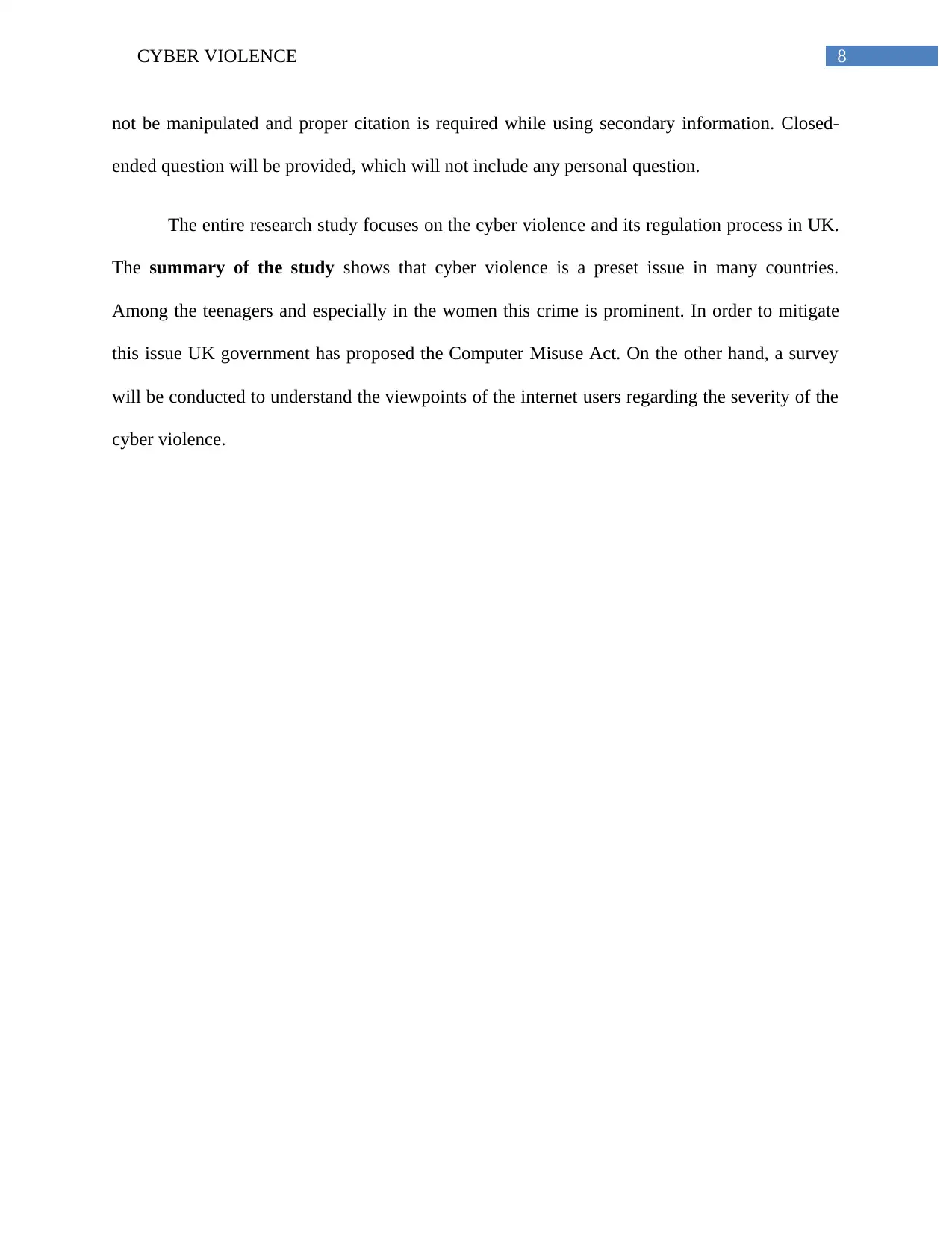
8CYBER VIOLENCE
not be manipulated and proper citation is required while using secondary information. Closed-
ended question will be provided, which will not include any personal question.
The entire research study focuses on the cyber violence and its regulation process in UK.
The summary of the study shows that cyber violence is a preset issue in many countries.
Among the teenagers and especially in the women this crime is prominent. In order to mitigate
this issue UK government has proposed the Computer Misuse Act. On the other hand, a survey
will be conducted to understand the viewpoints of the internet users regarding the severity of the
cyber violence.
not be manipulated and proper citation is required while using secondary information. Closed-
ended question will be provided, which will not include any personal question.
The entire research study focuses on the cyber violence and its regulation process in UK.
The summary of the study shows that cyber violence is a preset issue in many countries.
Among the teenagers and especially in the women this crime is prominent. In order to mitigate
this issue UK government has proposed the Computer Misuse Act. On the other hand, a survey
will be conducted to understand the viewpoints of the internet users regarding the severity of the
cyber violence.
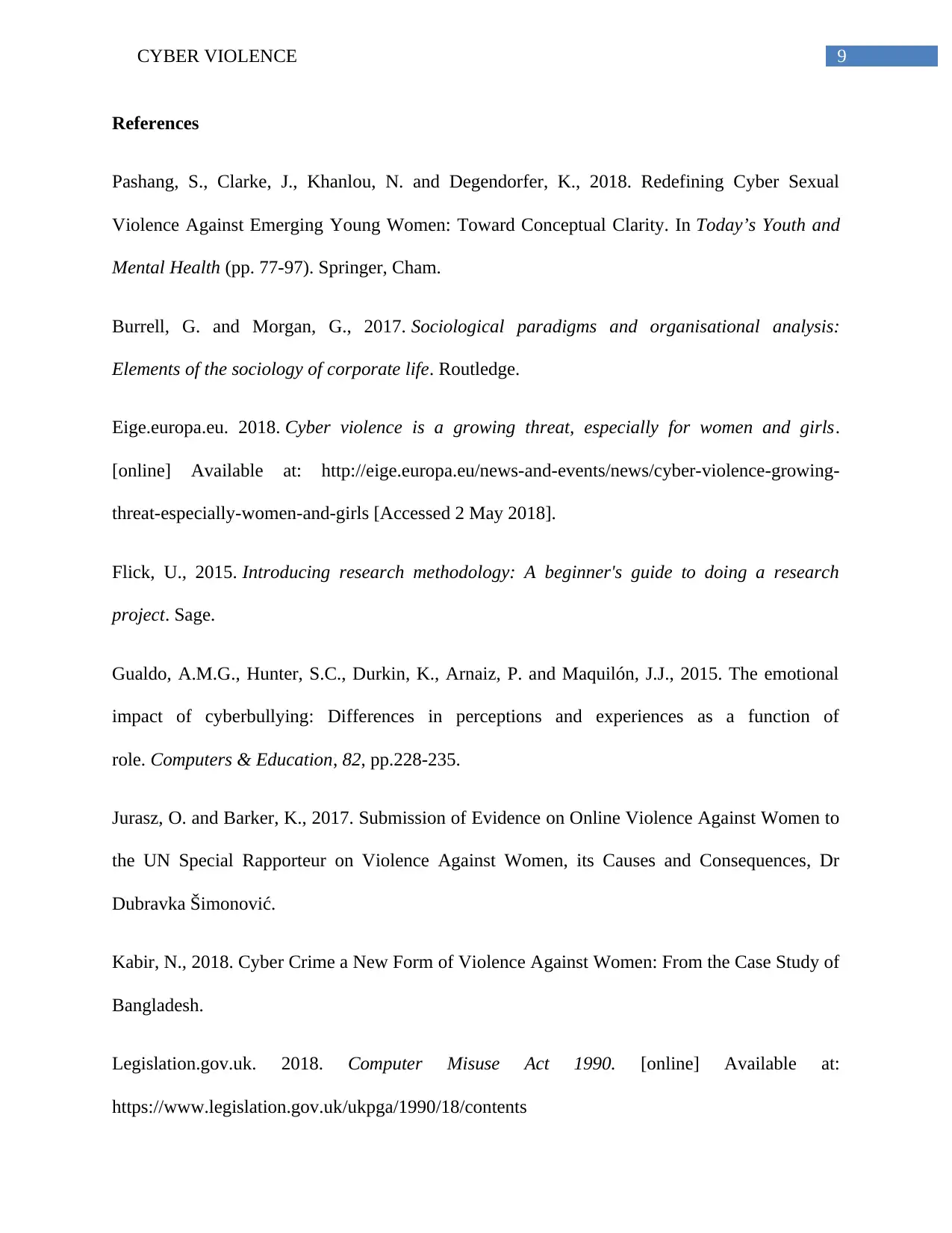
9CYBER VIOLENCE
References
Pashang, S., Clarke, J., Khanlou, N. and Degendorfer, K., 2018. Redefining Cyber Sexual
Violence Against Emerging Young Women: Toward Conceptual Clarity. In Today’s Youth and
Mental Health (pp. 77-97). Springer, Cham.
Burrell, G. and Morgan, G., 2017. Sociological paradigms and organisational analysis:
Elements of the sociology of corporate life. Routledge.
Eige.europa.eu. 2018. Cyber violence is a growing threat, especially for women and girls.
[online] Available at: http://eige.europa.eu/news-and-events/news/cyber-violence-growing-
threat-especially-women-and-girls [Accessed 2 May 2018].
Flick, U., 2015. Introducing research methodology: A beginner's guide to doing a research
project. Sage.
Gualdo, A.M.G., Hunter, S.C., Durkin, K., Arnaiz, P. and Maquilón, J.J., 2015. The emotional
impact of cyberbullying: Differences in perceptions and experiences as a function of
role. Computers & Education, 82, pp.228-235.
Jurasz, O. and Barker, K., 2017. Submission of Evidence on Online Violence Against Women to
the UN Special Rapporteur on Violence Against Women, its Causes and Consequences, Dr
Dubravka Šimonović.
Kabir, N., 2018. Cyber Crime a New Form of Violence Against Women: From the Case Study of
Bangladesh.
Legislation.gov.uk. 2018. Computer Misuse Act 1990. [online] Available at:
https://www.legislation.gov.uk/ukpga/1990/18/contents
References
Pashang, S., Clarke, J., Khanlou, N. and Degendorfer, K., 2018. Redefining Cyber Sexual
Violence Against Emerging Young Women: Toward Conceptual Clarity. In Today’s Youth and
Mental Health (pp. 77-97). Springer, Cham.
Burrell, G. and Morgan, G., 2017. Sociological paradigms and organisational analysis:
Elements of the sociology of corporate life. Routledge.
Eige.europa.eu. 2018. Cyber violence is a growing threat, especially for women and girls.
[online] Available at: http://eige.europa.eu/news-and-events/news/cyber-violence-growing-
threat-especially-women-and-girls [Accessed 2 May 2018].
Flick, U., 2015. Introducing research methodology: A beginner's guide to doing a research
project. Sage.
Gualdo, A.M.G., Hunter, S.C., Durkin, K., Arnaiz, P. and Maquilón, J.J., 2015. The emotional
impact of cyberbullying: Differences in perceptions and experiences as a function of
role. Computers & Education, 82, pp.228-235.
Jurasz, O. and Barker, K., 2017. Submission of Evidence on Online Violence Against Women to
the UN Special Rapporteur on Violence Against Women, its Causes and Consequences, Dr
Dubravka Šimonović.
Kabir, N., 2018. Cyber Crime a New Form of Violence Against Women: From the Case Study of
Bangladesh.
Legislation.gov.uk. 2018. Computer Misuse Act 1990. [online] Available at:
https://www.legislation.gov.uk/ukpga/1990/18/contents
⊘ This is a preview!⊘
Do you want full access?
Subscribe today to unlock all pages.

Trusted by 1+ million students worldwide

10CYBER VIOLENCE
Nixon, C.L., 2014. Current perspectives: the impact of cyberbullying on adolescent
health. Adolescent health, medicine and therapeutics, 5, p.143.
Owen, T., 2017. Cyber Violence. In Crime, Genes, Neuroscience and Cyberspace (pp. 103-114).
Palgrave Macmillan, London.
Peterson, J. and Densley, J., 2017. Cyber violence: What do we know and where do we go from
here?. Aggression and violent behavior, 34, pp.193-200.
Silverman, D. ed., 2016. Qualitative research. Sage.
Slonje, R., Smith, P.K. and Frisén, A., 2017. Perceived reasons for the negative impact of
cyberbullying and traditional bullying. European Journal of Developmental Psychology, 14(3),
pp.295-310.
Taylor, S.J., Bogdan, R. and DeVault, M., 2015. Introduction to qualitative research methods: A
guidebook and resource. John Wiley & Sons.
Theguardian.com. 2018. Half of UK girls are bullied on social media, says survey. [online]
Available at: https://www.theguardian.com/uk-news/2017/aug/14/half-uk-girls-bullied-social-
media-survey
Whitty, G., 2017. Sociology and school knowledge: Curriculum theory, research and politics.
Routledge.
Nixon, C.L., 2014. Current perspectives: the impact of cyberbullying on adolescent
health. Adolescent health, medicine and therapeutics, 5, p.143.
Owen, T., 2017. Cyber Violence. In Crime, Genes, Neuroscience and Cyberspace (pp. 103-114).
Palgrave Macmillan, London.
Peterson, J. and Densley, J., 2017. Cyber violence: What do we know and where do we go from
here?. Aggression and violent behavior, 34, pp.193-200.
Silverman, D. ed., 2016. Qualitative research. Sage.
Slonje, R., Smith, P.K. and Frisén, A., 2017. Perceived reasons for the negative impact of
cyberbullying and traditional bullying. European Journal of Developmental Psychology, 14(3),
pp.295-310.
Taylor, S.J., Bogdan, R. and DeVault, M., 2015. Introduction to qualitative research methods: A
guidebook and resource. John Wiley & Sons.
Theguardian.com. 2018. Half of UK girls are bullied on social media, says survey. [online]
Available at: https://www.theguardian.com/uk-news/2017/aug/14/half-uk-girls-bullied-social-
media-survey
Whitty, G., 2017. Sociology and school knowledge: Curriculum theory, research and politics.
Routledge.
1 out of 10
Related Documents
Your All-in-One AI-Powered Toolkit for Academic Success.
+13062052269
info@desklib.com
Available 24*7 on WhatsApp / Email
![[object Object]](/_next/static/media/star-bottom.7253800d.svg)
Unlock your academic potential
Copyright © 2020–2026 A2Z Services. All Rights Reserved. Developed and managed by ZUCOL.





